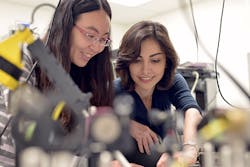UCLA-developed terahertz sensors work at room temperature
Researchers at UCLA have developed an ultrasensitive room-temperature terahertz imager that could enable astronomers to view galaxies, stars, and planetary systems in superb detail.1 Existing terahertz imagers of this type (near-quantum-limited heterodyne terahertz detectors) require cryogenic temperatures near 0 K.
The system produces images in ultrahigh clarity, and it can detect terahertz waves across a broad spectral range of 0.1 to 5.0 THz—an improvement of at least ten times over current technologies. Its broad range capabilities could allow it to do observations that currently require several different instruments. It identifies what elements and molecules, for example, water, oxygen, carbon monoxide, and other organic molecules, are present in those regions of space by seeking their individual telltale spectral signatures.
“In astronomy, the advantage of the terahertz range is that, unlike infrared and visible light, terahertz waves are not obscured by interstellar gas and dust that surround these astronomical structures,” says Mona Jarrahi, a UCLA professor of electrical and computer engineering who led the research.
The key to the new system is how it converts incoming terahertz signals, which are not easy to sense and analyze with standard scientific equipment, into radio waves that are easy to sense. In the system, a plasmonic metallic nanostructure on semiconductor accepts the terahertz radiation along with a heterodyning optical beam and a terahertz beat frequency to produce the radio waves. The sensitivity at room temperature reaches to three times the quantum limit.
Because the system is lightweight, it could be easily carried into space. It could help scientists glean new insights into the composition of astronomical objects and structures and into the physics of how they form and die. It could also help answer questions about how they interact with the gases, dust, and radiation that exists between stars and galaxies, and it could reveal clues about the cosmic origins of water or organic molecules that could indicate whether a planet is hospitable to life. (The system could also be used on Earth, to detect harmful gases for security or environmental monitoring purposes.)
Source: https://samueli.ucla.edu/ucla-developed-terahertz-sensors/
REFERENCE:
1. Ning Wang et al., Nature Astronomy (2019); https://doi.org/10.1038/s41550-019-0828-6.

John Wallace | Senior Technical Editor (1998-2022)
John Wallace was with Laser Focus World for nearly 25 years, retiring in late June 2022. He obtained a bachelor's degree in mechanical engineering and physics at Rutgers University and a master's in optical engineering at the University of Rochester. Before becoming an editor, John worked as an engineer at RCA, Exxon, Eastman Kodak, and GCA Corporation.
